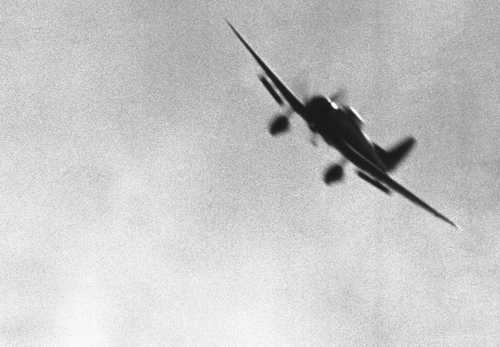
Japanese Forces
Pearl Harbour - bomb away ...
AP.
Japanese dive-bomber, photographed from the ground, over Pearl Harbour, 7 December, 1941. Dive brakes have been deployed, and the bomb appears to be away, suggesting that the pilot is pulling out of his dive. The aircraft is, almost certainly (certainly, in my humble opinion) an example of the Aichi D3A/Navy Type 99 Carrier Bomber Model 11 (Allied recognition name "Val"). Note the radial engine, "upright" cockpit and - pretty determinative - dorsal fin, a feature introduced to correct stability problems with earlier models. Standard armament consisted of 1 250 kilo or 2 60 kilo bombs, two fixed forward-firing 7.7mm Type 97 machine guns, and one rearward-firing 7.7mm Type 92 machine gun, mounted at the rear of the cockpit and manned by the observer-navigator. In spite of early teething troubles, the "Vals" that took part in the Pearl assault were very effective for their time, stable and yet agile and speedy (max. speed 389 km/h). It served the Japanese Naval Air Arm to the end of the war, and claimed an impressive toll of US Navy vessels and land targets. Towards the end of the war, it was even pressed into interceptor duties, in which its relatively high speed and agility made it a surprisingly effective substitute of the increasingly unavailable specialist interceptors and fighters. Best regards, JR.
2533 Views
7/28/2011
